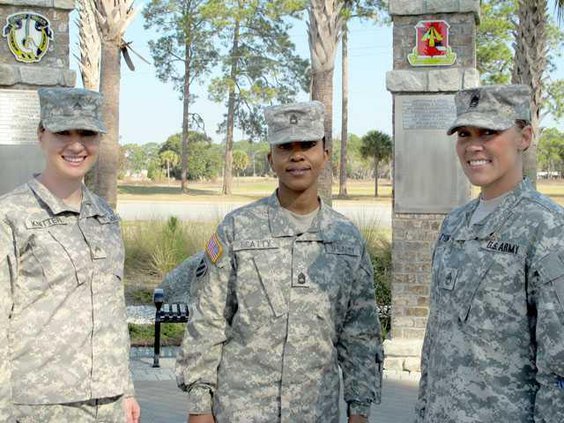Two female soldiers assigned to the 3rd Infantry Division’s 1st Armor Brigade Combat Team expressed different opinions about Secretary of Defense Leon Panetta’s lift of the ban on women serving in combat units. During media interviews held Tuesday outside their brigade headquarters the two soldiers talked candidly about the policy change.
Sgt. 1st Class Margaret Beatty and Sgt. 1st Class Michelle Tyson are not only the same rank; they’ve both served 13 years in the Army, and they’ve both served combat tours in Iraq with the 3rd ID. Beatty, a combat medic, agrees with the policy. Tyson, a tracked-vehicle mechanic, does not.
“I support the new policy allowing females to join combat-arms units like the infantry,” Beatty said. “For the past decade, women have been serving in Iraq and Afghanistan alongside male soldiers. If the opportunity is afforded to them, why not give them a chance?”
Beatty said she currently serves as the acting first sergeant for her company with the 3rd Brigade Support Battalion. During her three tours in Iraq, she served as a combat medic.
“I have served on the front lines,” she said. “Nothing has actually changed for me, but it would be a change to serve with an infantry unit. We haven’t had females that closely engaged.”
She believes her medics first would receive special training before attaching them to an infantry unit. While admitting there are some things female soldiers cannot physically do, she pointed out that many male soldiers also are physically unable to do some things required of infantrymen. Those women who are able to perform to the same physical standards should be afforded the same opportunity, she said.
“Being in an organization like the Army that supports equality and opportunity, I totally support the decision,” Beatty said. “But like any new policy change, it will take time.”
Tyson said she disagrees with the policy, but not because she is opposed to expanding opportunities for women. She questions whether the risk to unit cohesion, which she called its “culture,” is worth the potentially negative impact on the unit’s ability to accomplish the mission.
“I truly believe that women deserve more opportunity, but I disagree with opening some (military occupational specialties) to females,” Tyson said. “I think the Army is its own culture, but each MOS in the Army has kind of its own sub-culture. Adding females to the infantry, for example, would add another dynamic. It could have a big impact on our mission.”
She said just as there are some male soldiers who can’t meet the physical requirements, there are some females soldiers who probably can meet the physical requirements to be an infantryman, Ranger or Special Forces soldier. She questions why the Army would jeopardize the mission just to add a few female soldiers to all-male combat units.
“I know we have some females that can do it,” she said. “But I think it’ll disrupt that culture of the unit. I certainly would not support changing the physical standards to allow more women in the infantry ... I used to be an instructor for the Warrior Leaders Course. My battle buddy was a scout. In WLC, they train all soldiers to perform infantry-type tasks, including road marches. So I know a little about what the infantry does.”
Tyson said female soldiers already are serving on the front lines as military police, combat medics, interpreters and other roles. She admitted, however, that they’re not serving behind enemy lines, wearing the infantryman’s 75-pound rucksack with 30 pounds of body armor or carrying crew-served weapons like the 26-pound M240 machine gun or components to an 81mm mortar, consisting of a 56-pound bipod, 28-pound barrel and 25-pound base plate.
Although she knows some females physically are capable of carry the same weight, Tyson reiterated the risk of disrupting unit cohesion to add a few female soldiers is not worth it.
Women in combat raises questions


Sign up for our e-newsletters